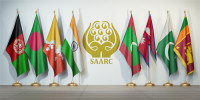Opinion
Neighbourly lessons
There are a few lessons we can learn from other countries to boost our shaky economy
Bishnu Prasad Bhandari
Nepal was hit by an earthquake in April 2015 and a number of aftershocks after that. The tremor caused destruction valued at more than $7 billion as per the Post-Disaster Needs Assessment. The promulgation of the constitution on September 20 brought hopes and prospects of a betterment in the livelihood and economic growth of the country. At the same time, some groups launched an agitation claiming that the constitution did not address the aspirations of the people in the southern parts of the country. The earthquake resulted in a huge loss to the economy. Moreover, civil unrest and the resulting disruptions in the supply of essential goods has made life hard for the people. Food to eat, medicines to treat diseases and fuel to cook food and commute to work have become scarce. Millions of industrial workers have become unemployed as factories and businesses have closed down. The country as a whole has suffered directly and indirectly, and the economic condition is deteriorating day by day.
A white paper issued by the Ministry of Finance on November 24 said that the Gross Domestic Product (GDP), which was originally expected to increase at the rate of 6 percent, was now expected to grow at only 2 percent if the unrest and disruptions continued. Capital expenditure stood at 4.1 percent as of the end of the first four months. Inflation surged to 8.3 percent as of mid-October from 7.2 percent at the beginning of the fiscal year, and it is predicted to increase further. The Federation of Nepalese Chambers of Commerce and Industry estimated the loss to the economy to have reached $1 billion as of October 3. Moreover, the economic indicators provided in the white paper are alarming. Against this backdrop, a few sectors which can be taken as priority sectors and drive an economic recovery have been summed up below.
Agriculture for self-sustenance
Agriculture is Nepal’s principal economic activity, employing 70 percent of the population and contributing 37 percent of the GDP. About 20 percent of Nepal’s total area is cultivable, 33 percent is forested and most of the rest is mountainous. Rice and wheat, accounting for 21 percent and 7 percent of the total agro production respectively, are the main food crops. The lowland Tarai region produces an agricultural surplus, part of which fulfils the needs of food-deficient hill areas. Agricultural growth, as mentioned in the white paper, is expected to reach 1 percent this year while it was 1.9 percent in the last fiscal year.
Our northern neighbour China is the leading producer of rice and accounts for 26 percent of the world’s production. Nepal cannot be compared with China in terms of size and the economy, but it can learn from the technology and irrigation system used there. Short-, medium- and long-term plans with an effective level of implementation can enhance the possibility of success.
Hydroelectricity and tourism
Nepal is rich in hydropower, and has a technically and economically viable potential of 40,000 MW. As stated in the white paper, the present output totals 716 MW which leaves a deficit of 470 MW. Nepal imports 236 MW from India which accounts for 30 percent of the total national electricity supply. China has constructed the world’s largest hydroelectric plant with a capacity 22,500 MW. It cost $26 billion and took 16 years to build. The history of the project’s initiation, funding composition and dimension, power generation and distribution, environmental impact assessment, management of local issues and other matters can be studied in detail for the effective implementation of hydro projects in Nepal.
Tourism is a key foreign exchange generating sector of the economy. Nepal is a hotspot for mountaineers, rock climbers and adventure seekers with eight of the 10 highest peaks in the world. The country also possesses a profusion of religious, cultural and natural assets that attract foreign visitors. Tourism accounts for more than 4 percent of the GDP. According to the white paper, the number of tourists visiting Nepal by air reached only 300,325 compared to 652,655 during the period January-October 2014, a decline of 46 percent. Their average length of stay has also plunged from 12.4 days to just 6 days. In Cambodia, the tourism industry accounts for more than 10 percent of the GDP and is the country’s second largest source of hard currency. Arrivals totalled 4.5 million in 2014. Though the volume of earnings and economic status of the two countries are not comparable, Nepal has ample opportunities in the tourism sector.
Need of the hour
The spectre of a humanitarian crisis as predicted by various national and international agencies is very alarming. The first thing that needs to be done is forging a consensus among the political parties and resolving the political issues. Political and economic growth and social development are interlinked. The Reconstruction Authority should set the pace. The government should formulate short-, medium- and long-term plans, and implement them effectively. There should be good governance. In order to promote foreign direct investment, diplomatic relations have to be strong. The economy should be developed at both the micro and macro levels.
Desires and actions to fulfil them are very important, and the economic sector is no exception. It is one thing to boast about the country’s potential in terms of natural resources and cultural assets, but translating plans into action is something else. Performance is important. So, if we start moving, economic progress will not be far away.
Bhandari is a chartered accountant




 14.12°C Kathmandu
14.12°C Kathmandu










